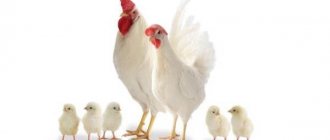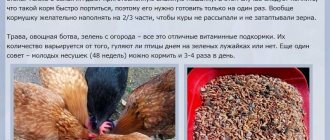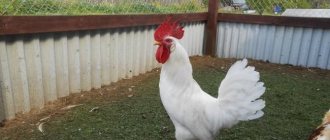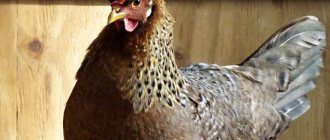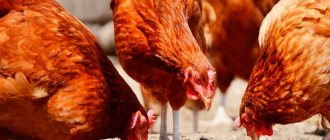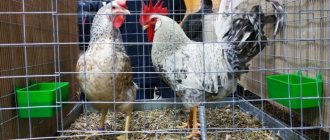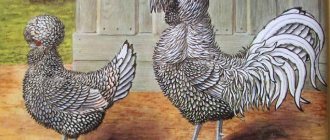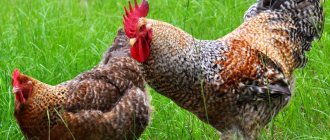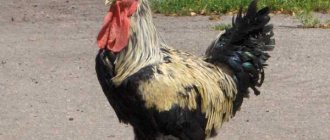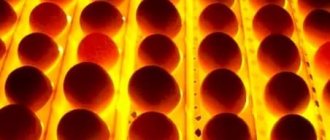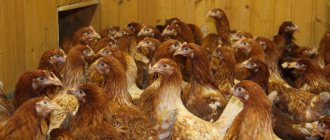Breed characteristics
The description of Andalusian chickens includes several distinctive qualities:
- the bird has a slender constitution, the weight of the hen is about 2 kg, the weight of the rooster is 2.5-2.7 kg;
- earlobes are elongated, white with a smooth surface;
- face reddish;
- eyes round, brown;
- light-colored skin, almost snow-white;
- the surface of the paws is light yellow with a blue tint;
- the beak is small, bluish in color;
- the comb is leaf-shaped, in chickens it is lowered to the face, in roosters it is erect.
The neck and body are elongated, the chest is of medium width. In males, the tail is located at an angle of 90° relative to the bone.
The belly and chest areas have lighter plumage than the back and mane. The feathers are unusual - steel blue with a dark edge.
Where can I buy
You can purchase hatching eggs, young or adult chickens at several poultry farms in Russia - Kurkurovo, Veselaya Ryaba, Bird Village.
The cost of seven-day-old chicks is 300 rubles, two-week-old chicks are 350 rubles. The price for one hatching egg is 200 rubles.
Breed standards and description of appearance
According to the characteristics, roosters must have large combs and regular shape; there may be some flaws. The tail feathers are slightly curved, set straight, folds are unacceptable. The skin of the face is scarlet, the color is blue with a charcoal edging, there should be no red spots, the presence of a black tail or white feathers, both in the tail and on the wings, is also considered a defect.
Andalusian blue rooster
The appearance of the laying hens is almost perfect. Breed standards are the same for both sexes. Roosters and hens are distinguished by their crest: in the former it is quite large in size, the teeth are clearly visible, in the latter it leans to one side. The eyes are coffee-colored and may have a reddish-yellow tint. The beak is gray in color and is of medium size.
The feathers on the earlobes are slightly lighter than on other parts of the body. The earrings are covered with delicate scarlet skin. The head has an elongated shape, the forehead is rounded and convex. The neck is of medium length with a slight arch. The thoracic and dorsal regions are wide and rounded.
The feathers are thick and fit tightly to the body. Unusual is the blue color, which has a black edging on each feather.
Andalusian blue chicken
The wings, firmly pressed to the sides, are set high. The tail feathers are curved and set back slightly. The legs are well developed, with gray skin; in young animals they are black.
Features of crossing
Very often we observe a picture when, of the entire brood, only 50% of the offspring turn out to have blue plumage, the second half with a white or tar color.
Genetics influences tone changes. This breed has two genotypes - black and blue. Therefore, when crossing birds with different colors, the chickens can be varied:
- some chicks (about 50%) will carry a combination of 2 genes;
- just over 15% will have black plumage;
- a quarter are blue individuals with light inclusions, which are also called splash.
When crossing the last two, the probability of obtaining young animals with a rich blue color is almost 100%
Is the Andalusian chicken on the verge of extinction?
The fantastic color of the bird makes everyone fall in love with it. But the very first offspring that an inexperienced farmer receives is unpleasantly surprising: only half of the chickens will be pale blue. The remaining birds have black and white plumage with dark spots. But don’t be scared and discard unsightly chickens. This result is predictable and explained by simple genetics.
Andalusian blue chicken
The Andalusian blue chicken simultaneously has two genes: blue and black. When such birds give birth to offspring, according to the laws of genetics, they turn out to be diverse:
- half will carry both genes;
- a quarter - only the black color gene - these are absolutely black birds;
- a quarter - only the gene for blue coloring - these are light ones interspersed with chicken, the so-called “splash”.
If you cross birds of the last two colors with each other, then absolutely all the chicks will turn out to be bright blue. For a farmer who is interested in obtaining and breeding beautiful Andalusian birds, it is useful to have a table of the colors of the chicks:
| Parents | Blue chicks | Black chicks | Light chicks |
| Blue rooster + blue hen | 50% | 25% | 25% |
| Blue rooster + black hen | 50% | 50% | 0 |
| Blue rooster + light hen | 50% | 0 | 50% |
| Black rooster + blue hen | 50% | 50% | 0 |
| Black rooster + light hen | 100% | 0 | 0 |
| Black rooster + black hen | 0 | 100% | 0 |
| Light rooster + blue hen | 50% | 0 | 50% |
| Light rooster + black hen | 100% | 0 | 0 |
| Light rooster + light hen | 0 | 0 | 100% |
As can be seen from the table, the danger of complete extinction of the Andalusian blue chicken is slightly exaggerated. It is absolutely impossible to get chicks with a beautiful blue coloring only by crossing two black or two light Andalusian birds with each other. In other cases, pleasing blue chickens will appear. Of course, dark or light hens cannot participate in exhibitions, but it is quite possible to get beautiful purebred offspring from them.
In order to avoid unwanted crossbreeding, at the time of obtaining eggs for the incubator, you can simply seat the birds in several groups or separate roosters of unnecessary color.
Color variant of the Andalusian blue chicken
Temperament
Andalusian chickens have not only a beautiful and unusual coloring, but also a cocky character, similar to the Spanish one.
In the absence of a threat, they behave calmly; if a stranger appears, they begin to show aggression.
In such situations, the rooster dominates the hens and acts as the protector of the entire flock. To avoid a commotion in the hen house, they need to be planted correctly and the procedure for assembling the family must be carefully approached. Since any stress can negatively affect the productivity of laying hens.
Birds of this breed are distinguished by their leisurely nature and easily make contact with humans.
Sexual maturity and productivity indicators
Like most meat-and-egg breeds, winged Spaniards grow quickly and gain weight, but they go through puberty at a normal pace. Young quons can start laying eggs at about six months of age - there is no point in waiting for the eggs to appear earlier. On the contrary, it may be that laying hens begin their vigorous activity a little later - closer to seven months of age.
As for productivity, in winged beauties it is characterized by average indicators. Most laying hens produce about 180 eggs in 1 year, from the moment they begin laying. But rare hens can “step over” this border and produce about 200 pieces. The weight of the testicles is about 60 grams, and their shell must be white.
Performance
Chicken does not differ in productivity from other breeds
Growth and development in this breed is exactly the same as in other varieties.
The first egg production begins at the age of 6 months. In a year, one hen can lay up to 180 eggs, some more - up to 200 eggs. But this rarely happens.
Each egg weighs from 50 to 60 g. The surface is white and durable.
You should not breed this breed just for meat, because... chickens do not weigh more than broilers. The meat of young animals is of the greatest value - it has a delicate taste and practically no fat.
Life expectancy is 9-10 years, but a decrease in egg production can be observed already in the 4th or 5th year of breeding.
You can keep laying hens until they die, but as they age, they begin to get sick more often and their productivity drops significantly. Therefore, experienced breeders recommend replacing them every four years.
Andalusian blue chicken breed
Origin story
Unfortunately, today there are very few exotic Andalusians left. As you probably already understood from the name, the breed appeared in Spain, or more precisely, in Andalusia. No one can now accurately name the years of selection, but it is truly known which varieties were used as the genetic basis.
The Andalusian Blue chicken breed is descended from Minoroc and native chickens. Initially, breeders wanted to get a variety that would delight in its appearance, and would not be inferior in performance and would be universal. The result that the scientists obtained impressed the whole world - the Andalusian laying hen turned out to be universal, and combined equally meat and egg potential.
The main advantage of blue hens is not their productive features, but their decorative appearance, which is why today they are kept only as exotic, decorative birds.
Unfortunately, the population of these feathered beauties across the planet is decreasing every year, although it is too early to talk about the extinction of the species. Basically, birds are bred in breeding farms - they are handled by collectors and gene pools responsible for the preservation of species.
Advantages and disadvantages
The description of this breed includes several advantages:
- high decorative qualities;
- relatively good egg production;
- good survival rate in chicks is about 93%, in adults - 87%;
- Great taste of meat and eggs.
It has several disadvantages:
- the desire to hatch chicks and further maternal instinct are poorly developed, so incubators are often used for breeding poultry;
- deformation of the ridge, which leads to loss of decorative appearance;
- the breed is very rare and expensive - a week-old chick costs about 300, a two-week-old 350, a hatching egg - 200 rubles;
- afraid of cold and sudden temperature changes.
Andalusian blue breed of chickens - description, photos and videos
Author: Chicken Ryaba
Hello, dear readers! The Andalusian blue breed of chickens will be described in our material. Photos and videos are attached. You've probably heard about ornamental and exotic breeds, and maybe you yourself are the owners of such amazing birds.
Read also: Baytril for broiler chickens, ditrim, calcium borogluconate, tromexine, amprolium, metronidazole, tetrahydrovit, Baycox, instructions for use, video
But today we will consider a special representative of the world of exotic birds - the Andalusian blue chicken.
Content Rules
Poultry house
Birds should be kept in a dry, spacious and warm room with good ventilation and no drafts. The calculation of space is carried out as follows - at least 1 m² is allocated for 2-3 individuals.
If the area is smaller, the risk of developing diseases and parasites is high. At a lower density they will freeze in the chicken coop.
The bottom of the floor is covered with sheets of tin to eliminate the possibility of rodents entering. It is then whitened with slaked lime to prevent fungal infections. A thick layer of straw, dry peat or large sawdust is laid on top.
The laying of the flooring is carried out in dry and sunny weather, otherwise it will become saturated with dampness and can quickly become moldy. The litter is changed no more than once a year.
Chicken droppings and feathers that fall on the floor help maintain the desired humidity in the room.
To eliminate the risk of injury, adults are given perches that are not too high - up to 50 cm from the floor surface.
Ventilation and lighting
It is important to provide good lighting for 12-13 hours a day. The lighting should not be too bright or dim. Diffused daylight, which can be created using lamps, is suitable.
The second important condition is good ventilation. The room is ventilated daily by opening the window, doors or lid, depending on the type of structure.
In the absence of air exchange, there is a high risk of the development of pathogenic bacteria and microbes in a musty chicken coop.
The optimal temperature for keeping chickens is about 25°C. There should be no drafts, which contribute to sudden temperature changes and cause colds in birds.
Walking area
The chicken is kept in a confined space
The description of the Andalusian blue breed of chickens includes good productivity, subject to daily walking. Therefore, you need to take care in advance of a place for hens and roosters to walk.
The walking area is fenced with a high fence and a net is placed on top, since this bird is capable of flying high. The soil is sown with cereal grass in order to provide the chickens with green food for the summer in the future.
Due to their increased aggression and temperament, it is not recommended to keep them with other breeds. Frequent fighting can lead to injury and reduced productivity of both varieties.
Feeding ration
It is necessary to install feeders and drinkers in the chicken coop that are convenient and accessible to each individual. This breed has a good appetite and willingly eats any food. The diet includes:
- grain crops;
- weeds;
- industrial feed;
- leftover food from the table;
- wet mash prepared in fish or meat broth with the addition of vegetables and cereals, served warm.
In the summer, the amount of greens is increased, reducing the amount of grain and other feed in the winter diet. To increase egg production in the off-season, chickens are given sprouted wheat, barley, and rye. This feeding contains many vitamins and minerals. Additionally, laying hens are given gravel, shell rock, sunflower cake, legumes, fish and meat and bone meal.
The water in drinking bowls needs to be changed daily, especially if it is a simple container with an open top. It must be fresh and clean.
For convenience, many breeders use nipple or groove designs, in which the liquid remains of high quality longer.
Analogs
An analogue of the breed can be called Minorok chickens. They were used to obtain the Andalusian blue breed. They were bred by breeders on the islands of the Mediterranean Sea. The bird grows quickly and produces a good number of eggs, but is difficult to keep. This Mediterranean breed of chicken does not tolerate harsh winters, so it needs a reliable poultry house. It must be well heated so that the birds do not suffer from constant hypothermia.
Nuances of breeding
Breeding in a chicken coop is very rare, so breeders use incubators.
An important condition for successful hatching is a selection of high-quality eggs. Only fresh ones are selected (not older than 5 days) without cracks, with a flat and smooth surface. It is better to use medium-sized specimens.
The fertilization of eggs is quite high - about 95%. After laying and until the brood appears, a certain regime is maintained in the incubator - in the first 7 days 40°C, all subsequent weeks are lowered by 1°C. During incubation, the eggs are turned daily 3-4 times a day.
Hatched chicks are kept in a dry box at a temperature of 25°C with diffuse daylight.
Feeding young animals
Feeding begins after the fluff dries, when the chickens become active. The first dish is a boiled and chopped chicken egg.
From the third day of life they are fed cottage cheese, small greens and cereals. Juveniles eat frequently, so they need to be fed at least five times a day.
Up to three weeks of age, chicks require a large amount of protein, which strengthens bone tissue and prevents the development of rickets - minerals, fermented milk products, fish oil, and yeast are introduced into the diet. Additionally, coarse-grained, pre-calcined sand is provided.
To strengthen the immune system and increase activity, glucose (5%) is given instead of water for the first 3 days. All subsequent days offer clean, fresh water at room temperature.
Features of care
The main care for chicks is to ensure a stable temperature within 25-27°C, good lighting for at least 10 hours a day.
Sawdust or straw is used as flooring in the box, which is changed every five days. On sunny days they can be walked in the fresh air.
Starting from 2 weeks, chickens are transferred to an adult diet - they are given crushed feed. From the age of two months, young animals begin to be kept in a common herd.
Hatching chicks
Artificial incubation
You need to start breeding offspring by selecting a family. Both the rooster and hen must meet the standard and have no defects in appearance. Selected birds must be isolated from the flock to avoid unwanted mating of the hen by another male.
After two weeks, you can collect eggs for incubation. An egg of medium size is suitable, with an even, smooth shell, without damage - growths or cracks.
Selected eggs should be stored in a cool, dry place. It is advisable that the storage period does not exceed 5 days, otherwise the hatching rate will sharply decrease: from 93-95% to 80-70%.
The process of incubating eggs from Andalusian chickens is no different from other laying hens. After 21 days, chicks are born, covered with black or gray down. It is impossible to immediately determine the color of future feathers, only when the babies are fully feathered.
Taking care of chickens
The Andalusian breed is famous for the high percentage of chick survival mentioned above. But this does not mean that babies do not need care. Chicks should be kept in a growth box or brooder with 24-hour lighting and regular feeding.
Approximate feeding table for Andalusian chicks up to a month:
Babies' feeders should always be filled with fresh food. The drinking bowl should be of such a shape that the chicken cannot tumble into it and drown.
For one-month-old chickens, feed for adult birds is gradually added to their diet. By two months, chickens are ready for adult life and do not need baby food. However, until the bones of a young bird are fully formed, the food should be rich in minerals and vitamins.
Diseases
The Andalusian breed of chickens has good immunity against diseases; only when the conditions of detention are violated, with high humidity, dampness and cold, they suffer from colds.
To maintain the health of adults and young individuals, it is necessary to maintain these indicators at the required level. Young animals are vaccinated at an early age.
During the molting period, birds develop vitamin deficiency, so the diet should be especially rich and balanced.
Description of the Andalusian blue breed of chickens
All poultry is conventionally divided into categories: “egg”, “meat”, “meat-egg” and “decorative”. The latter serve as decoration, so manufacturers do not expect great performance from them. The Andalusian blue breed of chickens falls into this category. But as a result of the work of breeders, the egg production of the breed has reached a high level.
Andalusian blue chicken breed
Advantages and disadvantages of the breed
Blue chickens are very interesting for poultry collectors because they are not a very popular breed due to their characteristics, and this in turn gives them value.
Advantages:
- has proven itself well as an egg breed, along with good meat production;
- unpretentiousness in care and nutrition;
- decorative external data.
Flaws:
- the brooding instinct is not sufficiently developed;
- An adult bird is characterized by an average level of survival.
- Sensitivity to cold.
- The chicken breed is expensive and rare
Despite the minor imperfections of the species, the presence of at least a few of these representatives on the territory of the poultry house will definitely not go unnoticed.
Character
The temperament of representatives of the blue breed is much more interesting than their color.
Blue chickens have a calm and leisurely disposition, but can show their aggression if their boundaries are violated.
Males will not tolerate encroachment on chickens and do not get along with roosters of other breeds in the same chicken coop.
Birds have excellent contact with humans, especially if they live for a long time.
They get used to changes in climate and terrain quickly, but at first do not disturb them so that they can recover from stress.
Feeding and required diet
This breed does not need a strict diet. Andalusian chickens are distinguished by their ability to consume food in moderation. The main condition of nutrition is a large amount of protein and vitamins. Fiber and carbohydrates are also needed for a balanced diet.
Andalusian chickens are distinguished by their ability to consume food in moderation.
The basis of the diet consists of wet grain porridges made from oats, millet, barley, corn, and peas. Boiled potatoes, fodder beets and carrots, and herbal mixtures are added to them. The amount of greens per day should not fall below 30 g. The presence of crushed fish or meat waste in the mash is mandatory.
The food is slightly salted, chalk and meat and bone meal are added a couple of times a week. In winter, fish oil is used. Many breeders recommend switching to special high-calorie feed during cold weather. In summer the porridge is made thinner, in winter it is warmer.
The sufficiency of feeding is determined by the behavior and weight of the birds. If the birds eat the contents of the trough in less than 30 minutes, the portion should be increased.
Many breeders recommend switching to special high-calorie feed during cold weather.
Important. If there is food left in the dish for longer than half an hour, it should be removed so that it does not turn sour.
At 1 month, the chicken should weigh at least 250 g, by 3 months - about 1.2 kg, at 5 months - almost 2 kg. If there is a lack of weight, there is malnutrition.
Feeding an adult herd
For adult birds, the feeding regime is no longer as important as the diet. Andalusian laying hens are unpretentious in this matter, but they can suffer due to errors in menu planning. First of all, an incorrect diet affects their health, and as a result, their appearance suffers, and productivity indicators also decrease. To avoid such consequences, you need to maintain a balance of essential substances in your daily diet. Here are some tips to help you make your meals nutritious and healthy.
- Like nothing else, protein, as well as other substances obtained from insects, larvae and worms, are suitable for meat and egg quacks. Therefore, whenever possible, feed them such delicacies.
- Meat and fish waste are good sources of animal proteins, but they must be fresh.
- Wet mash prepared in fish or meat broth, with the addition of vegetables and cereals, is quickly and well absorbed by bird stomachs. If the weather is cold, it is advisable to serve them warm.
- In the summer, chickens find their own vitamins in the walking yard - they happily nibble the grass, but in winter it is worth using stored hay supplies, as well as flour from grass or pine needles, so that the residents of the poultry house do not suffer from vitamin deficiency.
- When an adult herd has completed the growth phase, it can be switched to feed that contains less protein.
First of all, let's consider in what climatic conditions the Spanish beauty can feel normal. Chickens can tolerate hot periods quite normally, but they have big problems with cold resistance. Therefore, they will not be able to withstand winters in regions with harsh climates.
Poultry farmers in central Russia successfully keep these chickens, but at the same time they have to place them in heated poultry houses for the winter. The feathered beauty feels good in winter in its “native” climate - in Andalusia the air temperature during this period does not fall below +10 degrees. In addition to climate requirements, there are several more rules for care and maintenance.
- It is not recommended for pedigree herds to be kept with representatives of other varieties. Firstly, it helps maintain genetic purity. Secondly, it will help avoid conflicts and cockfights.
- The herd is sensitive to precipitation and the scorching sun, so it needs a canopy under which it can hide in case of precipitation or heat.
- Multi-level perches can cause injuries, and floor maintenance is fraught with deterioration in the appearance of Spaniards. The best option is low perches-poles, at a height of up to 50 cm from the floor.
Age-related decrease in egg production
The lifespan of exotic Spanish cats is approximately 10 years, but a decline in performance can be observed as early as the fourth year of life. Purely theoretically, quons can be kept while they are alive, and there is no planned replacement of the herd.
But aging laying hens get sick more often and practically do not produce any fruits of their activity. Therefore, it is recommended to carry out a scheduled replacement every 4 years.
Frequent illnesses
The survival rate of young and adult chickens is about 93-95%. To prevent Andalusian hens from getting sick, you should strictly adhere to the vaccination calendar and take all the necessary preventive measures.
Despite the fact that this species has strong immunity, it is not protected from parasites and infectious diseases. Spaniards are prone to colds due to hypothermia and high humidity in the poultry house. Also, often during the molting period they suffer from vitamin deficiency.
What are the reviews?
>Advantages
- External attractiveness.
- Unpretentiousness.
- Good survivability.
- Good performance.

